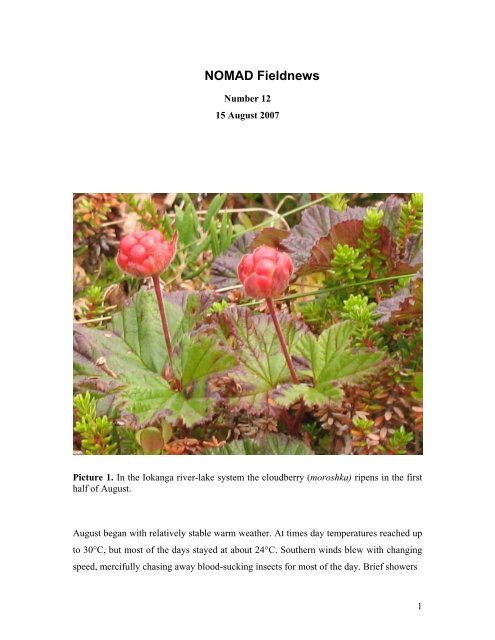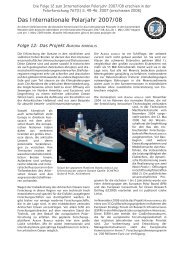Create successful ePaper yourself
Turn your PDF publications into a flip-book with our unique Google optimized e-Paper software.
<strong>NOMAD</strong> <strong>Fieldnews</strong><br />
Number 12<br />
15 August 2007<br />
Picture 1. In the Iokanga river-lake system the cloudberry (moroshka) ripens in the first<br />
half of August.<br />
August began with relatively stable warm weather. At times day temperatures reached up<br />
to 30°C, but most of the days stayed at about 24°C. Southern winds blew with changing<br />
speed, mercifully chasing away blood-sucking insects for most of the day. Brief showers<br />
1
Picture 2. A colorful rainbow marks the end of yet another summer shower.<br />
intervened, facilitating the rapid growth and ripening of numerous kinds of berries and<br />
mushrooms.<br />
At this time, according to plan, the <strong>NOMAD</strong> team was back to the Ketkozero camp,<br />
getting ready for the start of the autumn migration. The first group of deer was not late to<br />
come: it passed Ketkozero Lake and continued its way to the forest zone on 3 rd August,<br />
using a short spell of insect-free weather and trying to keep to high ground. The<br />
abundance of mushrooms was a primary motivating factor for this early movement back<br />
to the woods.<br />
2
As reindeer herders predicted, such early migrating groups of reindeer would quickly get<br />
back to the open tundra, once the weather calmed down and a second wave of insects<br />
attacked. After the mosquitoes, it is the midge (moshka) that now came on the scene. The<br />
tiny insects bite the tender skin around the eyes of the animals, swelling the tissue and<br />
impairing vision. An even more dangerous enemy comes in the form of gadflies (ovod)<br />
which can make deer stampede for hours until they are fully exhausted. Both of these<br />
insect species, the warble and the skin fly, are strongly dependent on weather conditions,<br />
being especially sensitive to wind. Most favorable for them is calm and wet weather of<br />
the kind that descends before it starts to rain. For humans the bite is very painful as we<br />
both were able to register.<br />
Picture 3. Mushrooms and insects are the major factors that influence reindeer migratory<br />
behavior in August. The most attractive mushrooms are of the Boletus species, as the<br />
mushroom in the foreground (krasnogolovik).<br />
3
Our observations of reindeer behavior in the first half of August confirmed what we had<br />
encountered previously. We now have strong reasons to outline a pattern, according to<br />
which migration in the central part of the Kola Peninsula is very far from a clean and tidy<br />
picture of unidirectional movement of an imaginary monolithic herd. In reality, we can<br />
observe differential movements of many different groups and often – of individual<br />
animals. Moreover, the migration of many parts of this aggregate herd would follow at<br />
times a zigzag course between forest and open tundra, the direction being motivated by<br />
seasonal factors, such as the search for mushrooms and avoidance of insects noted above.<br />
From the point of view of a researcher, using the <strong>NOMAD</strong> field methods, i.e. following<br />
closely the movements of deer and people, the picture that emerges is one of complexity,<br />
often resisting ordering and explanation.<br />
Recognizing such complexity, we tentatively put forward the following general outline.<br />
Every single deer would move along a complex course that receives stronger individual<br />
contours in summer time and in what is nominally defined as summer pastures. In winter<br />
time, group behavior is paramount, as is well known. What is less readily noted,<br />
however, is that at any given season one may find groups or individual animals not where<br />
they are supposed to be on the grazing territory. Moreover, before they settle for either<br />
summer or winter pastures, the groups or individuals may oscillate between forest and<br />
tundra many times, using favorable chances, or avoiding dangers. In the final account it<br />
can be safely said, that with the type of very lax herding that prevails in Central Kola, a<br />
deer can freely move between the summer and winter pastures many more than the<br />
expected two times per year, and that can easily happen irrespectively of season.<br />
As we have encountered during previous fieldwork, many expected winter time roundups<br />
of reindeer have failed because of a sudden movement of a herd toward the Barents<br />
Sea coast (the summer pastures). Reindeer herders, the local experts of reindeer behavior,<br />
usually explain such movement with weather factors, or simply reindeer will, often not<br />
wishing to risk any reasonable explanation. Herders well recognize the fact that there are<br />
too many variables that may influence a reindeer decision of where to go on a territory<br />
which is characterized by relatively short distances between forest and tundra. With an<br />
4
ability to cross distances of up to 30 km a day, the longest distance between winter and<br />
summer grazing range in Central Kola is 100 km, while the actual zigzagged span is of<br />
roughly 50 kms along the longer axis. Or, in other words, should insect pressure in late<br />
summer diminish, and mushrooms ripen in the forest, the deer may go mushrooming<br />
there for a few days and then get back to the open tundra in case the pressure resumes.<br />
Given this picture of reindeer movement, the reindeer herders of the right wing prefer to<br />
wait for reindeer at camps, with rare forays to the tundra, to see where more sizable<br />
fragments may have moved. At each herding camp a few herders stay during the summer,<br />
observing how many reindeer would pass nearby. From this vantage point they can check<br />
when the more mass-scale migration toward the Iokanga line is to start and the time for<br />
autumn corralling may be expected to come.<br />
Picture 4. Individual animal crossing briefly into the forest zone in mid-August.<br />
5
Meanwhile, the main concern of people living in the tundra and the main factor behind<br />
human summer movements is berry-picking with pride of place held by the cloudberry<br />
(moroshka). Cloudberry’s high attractiveness lies in its economic importance, it fetches<br />
good prices at the numerous gathering points in Lovozero. A major player that utilizes<br />
this sub-arctic resource is the Swedish company Norfrys – the same that trades in<br />
reindeer meat, as we have described in earlier issues. The price at which people can sell<br />
cloudberry to the numerous local small middlemen, located at literally each corner of<br />
Lovozero in the summer, reached 90 rubles (approximately EUR 2.70) by mid-August.<br />
The profitability is increased by the fact that the berries are watery and heavy, i.e. easily<br />
making up “weight”. Herders from Brigade 1 of Krasnoshchel’e complained that<br />
although cloudberry is abundant this summer, it is more difficult than usual to pick it,<br />
because of the late spring frosts damaging the frail white blossoms.<br />
Despite such mishaps the movement of people around the herding camps was mainly<br />
subjected to the task of picking as much of the berry as could be transported to the<br />
village, where some part went for making preserves, but the greater part was to be sold<br />
for instant cash. All the trips of the vezdekhody of the Cooperative, made officially for<br />
providing building materials for the ongoing repairs of huts and corrals, were so planned<br />
as to utilize the best possible timing for picking and transporting the berries. This<br />
included also two helicopter trips, provided by the Forest Preservation Unit<br />
(Lesookhrana) sent out to scout for possible forest fires.<br />
While it may seem that picking of berries is not a factor of importance for reindeer<br />
herding per se, it is of more direct relation than commonly expected in at least two ways.<br />
First of all, because being employed as a herder gives access to more plentiful berry<br />
resources than the non-herding residents of Lovozero can enjoy. This also includes free<br />
of charge transportation to the village, either by vezdekhod, or more rarely – by<br />
helicopter. Secondly, it is a fringe source of cash, which is not to be ignored given the<br />
low salaries paid irregularly by the Cooperative. Finally, it is an occupation that<br />
characterizes principally the behavior of herders in August, instead of that role being<br />
played by properly herding activities. The fact that the Cooperative leadership condones<br />
6
this state of affairs and tacitly, but effectively supports it, highlights the recognition of the<br />
fact that the Cooperative is seen as a community supportive entity over and above any<br />
economic rationale propelling its activities.<br />
Picture 5. Reindeer herders from Brigade 8 alarm us that a person “had run away into the<br />
tundra” and got lost in an delirious state after excessive drinking. The occasion was the<br />
arriving of two vezdekhody from the village to the herding camp.<br />
In the first days of August a tragic incident occurred as part of the berry-oriented<br />
movements of the herding community. One evening, shortly after our return from the trip<br />
to the summer pastures, two reindeer herders from Brigade 8 visited us. They asked us to<br />
phone urgently the administration of the Cooperative and raise the alarm that a person<br />
had disappeared from Herding Camp 1. As it became clear later, the man was not an<br />
7
employee of “Tundra”, but had simply followed his friend, a herder from Brigade 1,<br />
possibly with the intention that they collect and sell berries together. To our greatest<br />
sorrow, the lost person never turned up in subsequent days and weeks, neither attempts<br />
by the herders to find him bore any fruit. The accident was reported to the police, but as<br />
herders shared with us, the usual police practice is to send their representative in a<br />
helicopter only when a dead-body is eventually discovered. According to the herders, this<br />
is the fourth such incident in recent years. By mid-August, the lost person, Alexander<br />
Riabkov of Lovozero, 33, was declared lost for good by the herders. “He is as good as<br />
buried”, they said (“My ego uzhe pokhoronili”).<br />
Text and photographs:<br />
Yulian Konstantinov,<br />
Vladislava Vladimirova<br />
8




